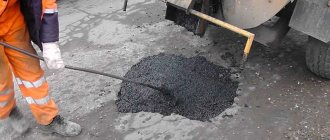In both road and household construction, asphalt consumers are equally concerned about one question: how long will my coating last? After how many years will it have to be repaired and replaced? After all, asphalt concrete mixtures are not that cheap. And they are taken specifically for a long service life.
If you look at the situation with domestic roads, which are repaired almost every year, the forecast seems to be disappointing. Does this mean that asphalt itself is a short-lived material? Let's figure it out.
In this article we will consider the following questions:
- Why are roads repaired so often in Russia?
- Standard service life of road surfaces
- How long will asphalt last in the yard of a house?
- How can you extend the life of asphalt?
Let's look at each of them in more detail.
Why are roads repaired so often in Russia?
Jokes about Russian roads have already become firmly entrenched in folklore. Some scold road workers and give them as an example the roads in Europe and the USA, which quietly lie without repair for 20 or even 30 years. Others object that our asphalt is in no way inferior to foreign ones, and the harsh climate is to blame. The truth, as is usually the case, is somewhere in the middle.
There are 4 main reasons for frequent repairs:
- Climatic conditions
- Increased loads on road surfaces
- Outdated road construction standards
- Violations of laying technology
Let's talk about each of them in a little more detail.
Climatic conditions
On the territory of Russia, 4 of the 7 existing climatic zones are represented: Arctic, subarctic, temperate and subtropical. That is, the variety of weather conditions in our country is enormous. And each region has its own characteristics that affect the operation of roads.
Here are the climatic factors that have a destructive effect on asphalt:
- Low temperatures When frozen to -15-20°C, the bitumen in asphalt becomes brittle and susceptible to cracking. Meanwhile, in many regions winter temperatures of about -30°C and below are considered normal.
- High temperatures At air temperatures of about 30-40°C, bitumen softens, and the coating is easily deformed and sags under the wheels of heavy vehicles. Such figures have recently become common even in milder climates, not to mention the southern regions.
- Frequent freeze-thaw cycles Every time water-saturated asphalt freezes and warms up, it loses some strength. And this process is repeated dozens of times over the course of a year.
- Weak soils In Russia, there are soils everywhere that have a low bearing capacity: waterlogged, clayey, peat bogs. The roads on them shrink and become deformed.
- Frost heaving of the subgrade This problem is related to the previous one. Poor quality soils expand in volume when they freeze and deform the upper layers of the road pie.
- Heavy precipitation Rain and melt water seep into the pores of asphalt and reduce its structural strength. And snowfall is almost always accompanied by the use of reagents, which also act aggressively on road surfaces.
As you can see, the climatic factor is really very important when building roads. But the situation is not limited to them.
Increased loads on road surfaces
Every year in Russia the intensity of traffic increases by 10-20%. And the development of industry leads to more and more heavy freight transport on the roads.
For clarity, here are a few examples of how the situation in the road industry has changed over the past 30 years:
| Index | In 1990-1991 | In the 2020s |
| Number of passenger vehicles | About 17 million | More than 45 million |
| Length of transport network | About 455 thousand km | More than 1.5 million km |
| Average traffic intensity | From 200 to 6000 cars/day. | From 1000 to 14,000 cars/day. |
| Freight turnover volumes by road transport | About 150 billion t*km | More than 270 billion t*km |
For your convenience, we have placed this table below in the form of a picture:
The dynamics are truly impressive. At the same time, the quality of road construction has not changed much over the same 30 years. This means that coatings that could easily serve for decades in the USSR are “killed” in just a few years under modern conditions.
Outdated road construction standards
Until recently, the main document that standardized the requirements for asphalt concrete mixtures (ABS) and asphalt concrete was GOST 9128. The first version of this standard was adopted in 1959, and the latest in 2013.
During these 50 years, GOST has not been thoroughly revised. Yes, new requirements were introduced, outdated classifications were abolished, and the limits of acceptable values for individual indicators were tightened. But the approach to designing mixture compositions and testing them remained unchanged.
Among the shortcomings of these state standards are the following:
- Requirements for the characteristics of asphalt do not take into account the climatic conditions of its operation and the level of traffic load
- Standard test methods (GOST 12801-98) do not reflect the loads to which asphalt is exposed in the pavement
- A number of important operational indicators are not standardized (for example, wear resistance and track depth)
To solve this problem, new standards began to be adopted in 2019-2020, based on the American Superpave system. It includes requirements for the quality of the raw materials used and a design scheme for ABS compositions for specific operating conditions.
These standards are represented by the following series of standards:
- GOST R 58401
- GOST R 58402
- GOST R 58406
- GOST R 58407
It is expected that all road services will switch to them by 2023. Until then, when constructing roads, it is allowed to use both the new rules and the usual GOST 9128-2013.
Violations of laying technology
This matter could not have been done without the human factor. Indeed, often asphalt becomes unusable simply because road workers neglect the rules for arranging roads and sidewalks.
During the construction and renovation season, the following shortcomings can be observed:
- Laying asphalt in cold weather, rain or snow, on a wet base
- Using cheap waste (broken bricks, construction waste) instead of durable crushed stone for arranging the base
- Long downtime of dump trucks with asphalt concrete mixture, during which the material cools down
- Laying asphalt directly on crushed stone without impregnating it with bitumen emulsion
- Laying a coating of insufficient thickness
This problem can only be solved through strict control over the quality of work performed. It would also be useful to adjust the budgets allocated for the construction and maintenance of roads. After all, it is the lack of funds that often pushes contractors to use cheap raw materials and attract unskilled workers.
We talked about how things work with Russian roads in practice. Now let's look at the documents and see how they rate the durability of asphalt.
Base and thickness of asphalt
We already know that we need to take into account not only the base material, but also not forget about the load. So, if the base is made of concrete, then a 6-centimeter layer of asphalt is enough to create a high-quality road surface, which is designed for small and medium loads. If you use crushed stone or broken brick as a base, then the lower threshold for the height of the asphalt layer varies from 12 to 18 cm: depending on whether it is a simple road or a highway (in the latter case, the base must be at least 30 cm).
A layer of asphalt with a thickness of 18 to 30 cm can withstand the load on busy highways; in this case, concrete or crushed stone of 4-5 different fractions serves as the base material. Take these standards into account when planning construction and budget, and then the coating will serve you for a long time, and you will spend exactly as much on the material as required.
Standard service life of road surfaces
All the reasons that we discussed above lead to the fact that road surfaces are repaired every 2-3 years, and even more often on streets with high traffic. Their total service life often does not exceed 10 years.
But on paper the situation looks different.
In regulatory documents you can find the following concepts:
- Guarantee period
- Time between repairs
Let's figure out what the difference is between them and what requirements are placed on them.
Warranty service life of asphalt
This is the period during which the contractor is obliged to eliminate defects found in the coating free of charge. It is counted from the moment the road is put into operation after construction or repair.
The warranty period does not say anything about the actual durability of the coating. In fact, this is a purely legal term. Contractors have the right to establish it at their discretion in their work contracts.
However, there are standard contract terms introduced by Order of the Ministry of Transport dated 02/05/2019 N37.
They establish minimum warranty periods for road pavements:
| Pavement layer | Warranty period, years | |
| Subgrade and foundation (during construction and reconstruction) | 8 | |
| Subgrade and foundation (during repairs, including major ones) | 6 | |
| Bottom layer of coating | 5 | |
| Topcoat and wear layer | Up to 1000 cars/day. | 8 |
| 1000-2500 cars/day. | 7 | |
| 2500-5000 cars/day. | 6 | |
| 5000-10,000 cars/day. | 5 | |
| 10,000-20,000 cars/day. | 4 | |
| From 20,000 cars/day. | 2 | |
For your convenience, we have placed this table below in the form of a picture:
The following deadlines are established for protective layers and surface treatments:
- With traffic intensity less than 2500 vehicles/day. – 1.5-2 years
- With a traffic intensity of more than 2500 vehicles/day. - 1 year
The warranty period performs a very important function. It motivates contractors to paving asphalt responsibly. After all, if the new road becomes covered with holes and cracks a year after it is put into operation, then careless builders will have to redo everything at their own expense.
Between repairs of roads
This is the period from the moment the coating is put into operation until the next routine or major repair. It is used to calculate funds allocated from the budget for capital and current repairs of roads.
They are installed:
- For federal roads - Government of the Russian Federation
- For roads of regional or intermunicipal importance - Governments of constituent entities (republics, regions, territories, etc.)
- For local roads - administrations of municipalities (districts, districts, cities, villages)
The current deadlines for repairing federal roads were adopted by Decree of the Government of the Russian Federation of May 30, 2022 N658.
It gives the following figures:
- For roads I-IV categories Major repairs – 24 years Current repairs – 12 years
- For roads of category V (urban passages, rural roads) Major repairs – 10 years Current repairs – 5 years
This resolution replaced an older one adopted in 2015. Typically, in the previous edition, the time between repairs did not exceed 10-12 years for major repairs and 4-6 for current ones. It is assumed that doubling them should have led to an improvement in the quality of roads. But so far there are very few coatings in the country that actually meet the requirements.
For roads of regional, intermunicipal and local importance, the figures vary from region to region and from city to city.
Usually they do not exceed the following values:
- Major repairs – 10-12 years
- Current repairs – 4-6 years
You can find out the exact figures for your region or locality in the current cost standards for the repair and maintenance of highways.
We examined the main points related to the operation of asphalt concrete pavements. But this material is used not only in road construction, but also in household construction. What durability can you expect in this case?
Possible defects in asphalt pavement
Asphalt laying work on main roads may be accompanied by some defects appearing on the surface if the asphalt paving rules are violated.
When using a paver, short waves may appear on the pavement. In this case, you need to ensure a uniform supply of the hot mixture. Long waves will indicate that the temperature of the mass is not maintained or the roller is moving unevenly.
Tears may form on the canvas, which will be a consequence of improper operation of the screed plate. It will violate the compaction coefficient due to inappropriate temperature of the mass and the presence of foreign inclusions in it. In this case, it is necessary to strictly control the operation of the laying equipment; isolated small breaks can be eliminated immediately.
Temperatures above the norm approved by SNiP can lead to cracking or uneven surface texture due to the sharp contrast between the base and the hot mass.
Bitumen stains appearing on the surface are a consequence of a violation of the percentage composition of the mixture. They will make the surface slippery. Precise adherence to proportions will prevent this defect.
Poor quality seams are the rules of installation. To avoid them, the cold edge is heated with gas burners, and only then the hot mixture is laid.
Incorrect operation of the asphalt paving machine can result in different layer thicknesses or longitudinal cracks, so the equipment must be well adjusted.
Service life of asphalt pavement in the local area
Let us say right away that there are no requirements for the durability of asphalt in the courtyards of private and apartment buildings. This is due to the fact that the loads there cannot be compared with road loads. And any more or less high-quality variety of material can easily withstand them.
The approximate service life of asphalt will be as follows:
- For blind area – 15 years
- For sidewalks, paths, platforms - 10-12 years
- For driveways and parking lots – 8-10 years
These figures are indicative only. If the asphalt is laid according to the rules and is not particularly loaded during operation, then it can easily lie for 20 or 30 years. And vice versa - if the coating was chosen based on pedestrian traffic, but in practice trucks constantly roll on it, then there can be no talk of any durability.
It is quite possible to influence the “life” of asphalt if you properly care for it.
How does the load on the roadbed affect the thickness of asphalt?
First, let's look at what loads can be placed on an asphalt surface:
- There is no significant pressure on footpaths and sidewalks.
- If we are talking about access roads or parking areas for vehicles, then the load increases here.
- If mainly passenger cars move along the road, then the load cannot be called maximum either.
- If there is frequent passage of trucks, the impact on the roadway increases noticeably.
- If mainly heavy trucks move along the highway, then the load can definitely be classified as high.
As you understand, a different thickness of the asphalt layer is recommended for each item. If you plan to build a path, path or sidewalk, or to paving an area near your house (in general, if no cars will move along the asphalt area), then 1 layer of asphalt 3 cm thick will be enough. If we are talking about access roads, parking lots for passenger vehicles , near garages and other similar places, we recommend doubling the layer – up to 6 cm. Now let’s move on to roads. If an average load is expected on the road surface, for example, only the traffic of passenger cars, then three-layer asphalt can be laid with a total thickness of 12 cm. If freight vehicles will also pass along the road, then we add another layer - the total height of the asphalt becomes 18 cm However, there are also routes along which there is an intense flow of trucks. Here, even 3 layers may not be enough for full quality and long service life. In this case, asphalt can be made in at least 4 or 5 layers, however, as a rule, 30 cm is quite enough. As you can see, the consumption of materials in different cases can change several times. By the way, you can always find prices for work on the page: “Asphalt laying - price per m2 in Moscow.” If you decide that you need more than 1 layer of asphalt, it is recommended to glue the layers with bitumen, which will increase their adhesion. The base also needs to be shed with liquid bitumen, approximately 0.5-0.8 liters per sq.m.
How to extend the life of asphalt
Nobody wants to spend money on installing a coating that will have to be replaced in 2-3 years. And to prevent such a situation from arising, you need to approach the asphalting of your site wisely.
To do this you need:
- Choose the right material
- Follow the installation rules
- Proper care of the coating
Let's look at each point in more detail.
How to choose asphalt
We will not talk about how asphalt concrete mixtures are designed for road construction. For this purpose, there are many regulatory and methodological documents where this process is described in detail. But in the sphere of domestic use of asphalt there is no such strict regulation. But there is a wide variety of types and brands of material. And the consumer is often unclear what to pay attention to.
You can use the table below to select the type of material for a specific task:
For your convenience, we have placed this table below in the form of a picture:
| What is asphalt used for? | What material properties are important? | Recommended types of asphalt |
| Blind area | Waterproof Water saturation Waterproof | Hot high density any type |
| A sidewalk, path or area where cars will not drive | Water saturation Water resistance Frost resistance | Hot dense asphalt Cold fine or sandy |
| Driveway in the yard, entrance to the house | Strength Shear resistance Crack resistance Water saturation Water resistance Frost resistance | Hot high-density or dense types A, B Cold fine-grained |
| Parking lot, garage floor | Strength Creep | Hot high-density or dense types A, B |
For your convenience, we have placed this table below in the form of a picture:
We write about this in more detail in the article How to choose asphalt.
How to lay asphalt
Many characteristics of the future pavement are laid down at the stages of laying and compacting the asphalt mixture.
To “squeeze” the maximum out of the material, you need to follow these rules:
- Carry out installation in dry and warm (up to +5°C) weather
- Before laying, stir the mixture further so that it is homogeneous.
- If hot asphalt is used, it must be laid immediately after delivery - before the material cools down
- Hot asphalt must be compacted with at least a vibrating plate or a hand roller, or even better - a full-fledged road roller
- Cold asphalt pavement is best compacted with a vibrating plate.
- After laying on hot asphalt, it is better not to drive for 1-2 days to allow it to cool and harden; the cold variety has no such restrictions
Proper installation allows you to obtain a strong and durable coating.
You can find step-by-step instructions for using different types of asphalt in our articles:
- Hot asphalt laying technology
- Cold asphalt laying technology
- Technology for laying cut asphalt











